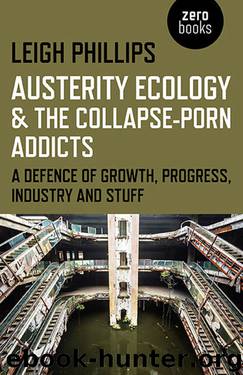Austerity Ecology & the Collapse-Porn Addicts: A Defence Of Growth, Progress, Industry And Stuff by Leigh Phillips

Author:Leigh Phillips [Phillips, Leigh]
Language: eng
Format: epub
ISBN: 9781782799610
Publisher: John Hunt Publishing
Published: 2015-10-29T18:30:00+00:00
How do we return to an age of steady innovative advance and ever increasing leisure time? In essence, we have to repeat the trick of how we achieved the Golden Quarter/Les Trentes Glorieuses in the first place.
And how did we do that? To answer such a question, we’ll need to take a brief economic history detour.
Let’s remember that the first genuine ‘Keynesian turn’—in form if not by name—initially occurred not after World War Two, but under Mussolini and Hitler. Between the manifest cataclysm of laissez-faire capitalism and the uncertain promise of Communism, it was the corporatist innovations of fascist economics that prefigured the Scandinavian, Swiss and American demand-management economic policies a few years later which were then embraced across western Europe after the war by governments of both left and right.85
Both fascist governments were able to overcome economic crisis by stimulating aggregate demand through massive investment directed by state agencies and the establishment of extensive and generous social programmes. Italy saw the establishment of work creation programmes involving house construction, marsh draining and highway, canal, railroad infrastructure roll-out. Government assumed control of credit allocation, with the fascist regime’s Istituto per la Ricostruzione Industriale in this period ultimately controlling 77% of pig iron production, 45% of steel production, 80% of naval construction and 90% of shipping.
When private capital was frightened of investing, the state became the investor of last resort. The regime also oversaw banking reform and nationalised the Bank of Italy. It also introduced the 40-hour work week, health insurance, paid national holidays, disability and old-age pensions, maternity benefits, and leisure-activity subsidies. State expenditure doubled between 1922 and 1933.
Meanwhile in Germany, when we ask ourselves how it is that so many people could tolerate the totalitarian barbarism of the Nazis, we have to understand that for many ordinary Germans who were not from minority groups or the left, the daily experience was not one of terror, but, as Gotz Aly argued in a 2005 essay in Der Spiegel, a ‘warm and fuzzy’ or ‘feel-good’ dictatorship: ‘Die Wohlfuehl-Diktator’86. Employment returned through a similar stimulation of demand, while the regime delivered family and child supports, decent pensions, free access to higher education and even cheap tickets for the theatre and concerts. There was an economic leveling and even social mobility. The well-being of the national community, ‘volksgemeinschaft’, was all-important. Life was indeed better.
But this all this was made possible not just by high rates of corporate taxation, near-autarkic capital controls and the state assumption of investment decision-making, but also ultimately slave labour (by Jews, eastern Europeans, political dissidents, homosexuals and POWs—amounting to 20 percent of the German workforce at its peak) and the conquering and economic draining of other economies.
Meanwhile, fascism also promised and delivered an end to the widespread class conflict of earlier decades. Independent working-class institutions were obliterated. Business leaders embraced what had previously been seen as fringe parties due to the social peace they imposed. Fascism is at base a response to crisis and strife.
Scandinavia in this period had also been the site of recurrent labour unrest.
Download
This site does not store any files on its server. We only index and link to content provided by other sites. Please contact the content providers to delete copyright contents if any and email us, we'll remove relevant links or contents immediately.
Man-made Catastrophes and Risk Information Concealment by Dmitry Chernov & Didier Sornette(5792)
The Revenge of Geography: What the Map Tells Us About Coming Conflicts and the Battle Against Fate by Kaplan Robert D(3973)
Zero Waste Home by Bea Johnson(3699)
COSMOS by Carl Sagan(3443)
In a Sunburned Country by Bill Bryson(3419)
Good by S. Walden(3404)
The Fate of Rome: Climate, Disease, and the End of an Empire (The Princeton History of the Ancient World) by Kyle Harper(2934)
A Wilder Time by William E. Glassley(2754)
Camino Island by John Grisham(2729)
Organic Mushroom Farming and Mycoremediation by Tradd Cotter(2586)
The Ogre by Doug Scott(2560)
Human Dynamics Research in Smart and Connected Communities by Shih-Lung Shaw & Daniel Sui(2436)
Energy Myths and Realities by Vaclav Smil(2394)
The Traveler's Gift by Andy Andrews(2314)
9781803241661-PYTHON FOR ARCGIS PRO by Unknown(2282)
Inside the Middle East by Avi Melamed(2258)
Birds of New Guinea by Pratt Thane K.; Beehler Bruce M.; Anderton John C(2194)
A History of Warfare by John Keegan(2125)
Ultimate Navigation Manual by Lyle Brotherton(2069)
